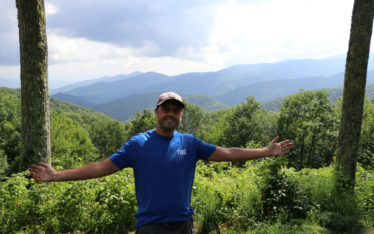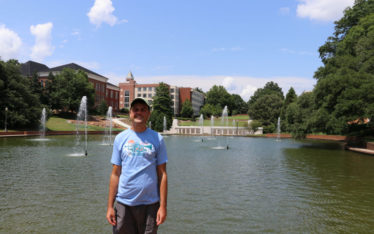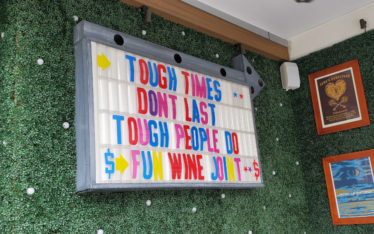We woke up after another cold night in St. Anthony’s. In the north of Newfoundland it still gets to the mid 30’s at night (even in early June) which for us who are living out of a van makes it feel pretty cold when you wake up in the morning. Today though, with no road left to go north we were finally going to go south then east towards St. John’s. So back on the road we went south, past the harbors filled with ice bergs and the small rocky fishing villages, past the endless mountains and finally past Gros Morne National Park again until we reached Canada Route 1. This section of backtracking alone took us 5 hours and we had still only seen the western edge of the island! We drove a few hours east before calling it a night in the west central part of the island. We found a campground called Kona Beach Park, which was on a lake and in a birch tree forest. It was a beautiful spot to be in after 8 hours of driving for the day.
The next morning we woke up and felt great. Not only did we wake up to a birch tree forest and lake view but we would finally be getting to the eastern side of the island today. The first stop for the day however was the town of Gander in central Newfoundland. For any aviation buff out there you should have probably heard of Gander. Gander is known as the “Crossroads of the World” for its airport. From the mid 1940’s through the late 1960’s any aircraft flying to or from Europe had to make a stop in little Gander to refuel. This wasn’t limited to just commercial aircraft but all aircraft (including private aircraft) had to stop in Newfoundland and usually stopped in Gander. This was due to the fact that even though Gander is a small town, its airport and runway (built by the British prior to WWII) is exceptionally long. The runway is so long in fact that it is an alternative-landing site for the space shuttle. Gander is also famous for its role during September 11, 2001. 38 commercial aircraft landed there, as the runway was so big. These planes carried over 6,000 passengers. This wouldn’t be a big deal in a city but Gander has a population of a little less than 10,000. So that was quite a lot of people. There have been a few books written and even a play produced of the generosity of the people in the town helping those passengers stranded until the United States airspace opened. One of the books which is a great read is “The Day the World Came to Town”. It took about an hour to get to Gander and we stopped to learn about all of this at The North Atlantic Aviation Museum. It was a great museum showcasing how the airport built the town of Gander, the years where planes had to stop to refuel and which celebrities of the day passed through and showcased the heroics of the townspeople on September 11th.
Leaving Gander we still had another 4 hours of driving before getting to St. John’s. It was a beautiful drive. The landscape went from forest-covered mountains dotted with lakes to rocky outcroppings then back to mountains all in a matter of hours. This even included driving through North America’s eastern most national park, Terra Nova. Just before reaching our final destination for the night we stopped in the most interestingly named town in Newfoundland; the town of Dildo. Yes this is a real place where people actually live. The town was named in the early 1700’s before any device of modern times was named. We stopped just to grab a few souvenirs as I had been year’s prior and Julie and I both wanted a memento from the town. It was just too good to pass up. Finally though we reached St. John’s. We settled down in St. John’s in a city run campground (Pippy Park if anyone is wondering – excellent for a city run campground) and planned out our 2 days in the city.
As Julie and I woke up the next day we were pretty excited. Today was going to be very fun. We packed up the car and hit the road. First stop for the day was Cape Spear, which is the most eastern point in North America. After navigating though some tight curves and steep slopes (St. John’s is very hilly!) we finally made it to the cape. We parked and looked around at the breathtaking scenery around us. Cape Spear is up on a cliff and since it was quite windy this day the waves were crashing with a lot of velocity creating huge mists in the air. It was really cool to witness. We walked around taking a few pictures. The entire area though was under construction and looked vastly different than when I had been there years prior with my great buddy Matt Ray. One of the things that I had found then so interesting were the bunkers left over from WWII. Now most of these had been destroyed except for one that Julie and I snuck into. Even though all the construction was going on it was still beautiful there. It was a bit of a strange feeling as well knowing that as early as we were in the trip we could not get any further east than we already were.
We left Cape Spear and headed to our second adventure of the day, which was a whale a watching tour. We hopped the boat with the other passengers and were excited for the tour. Almost immediately the captain spotted a Minke whale. This whale was round 25 feet long and just came to the surface for air before going back under. We followed it for a little while before heading further out in search of a Humpback whale. Not too long after starting to look for one a shout was heard and the puff of water from the blowhole was seen. After following it for a few minutes it surfaced again and this time brought its enormous tail up and out of the water. It was a really cool thing to see this massive whale (the one we saw was somewhere in the 40 foot range) right next to the boat. Next up was a bird colony island where we would see the largest Puffin colony in Newfoundland. When we got near to the island it was incredible. The sun had broken through the clouds making the blue water pop and the little black puffins that much easier to see. This was a very good thing as Puffins are nowhere as big as you think they are at only about 13 inches. They also have to flap their wings at a very fast rate (over 400 times per second) to stay in the air. So we watched these little black dive-bombers going into the water then up and around us. It was a very neat thing to see. Lastly on the tour was to see an iceberg stuck out in one of the harbors. Now Julie and I didn’t think that we would be that excited about an iceberg as we had seen hundreds of them days prior in St. Anthony’s however this one was huge. It was at least 10 times bigger than any that we could see from shore and beautiful. The boat was able to get fairly close and you could see the runoff happening, which opened the iceberg up revealing all sorts of shades of blue. It really was the perfect ending to the tour. After leaving the tour we stopped at a grocery store buying some supplies (including moose pepperoni) then headed back to the campground for the night.
The next day we woke up and we were ready to explore the city of St. John’s. First stop of the day was Signal Hill. Signal Hill is the tallest point in St. John’s overlooking the city and its harbor. Military fortifications have been on this hill since the late 1700’s. The hill had been used to signal ships coming into the harbor as well as a lookout in the 1800’s and 1900’s as well as the location of the 1st transatlantic wireless telecommunication. We walked around the museum showcasing artifacts as well as watched a short film on the site. Then we walked outside and took in the view. It really is a great view as on one side you have the Atlantic Ocean and on the other side you have the harbor, city and its suburbs. Next stop for the day (after a stop for a beer tasting at Newfoundland’s oldest brewery Quidi Vidi) was the city itself.
The city of St. John’s is based around its harbor. It’s old and historic yet colorful as well. We parked Bubbles and set out to find “Jellybean Row”. Jellybean Row is a neighborhood of row houses in the city that are painted all different colors. No house is the same color as the one next to it. We were told that one of the theories of why the houses were painted this way was so that the sailors could pick them out by color when coming in from a long voyage. The other theory is that the lobstermen would paint the house the same color that they painted their lobster trap buoy’s using the leftover paint they had. Regardless of how it came to be Jellybean Row (which is actually a few blocks) is a pretty cool spot to see. After lunch and a little shopping Julie wanted to see some music. St. John’s is known for having the most pubs per square kilometer in all of Canada and most on their pub street – George Street have live music. The day before we were told at Pippy Park to check out O’Reillys Newfoundland Irish bar. It was still early in the day, somewhere around 5pm but there was already live music playing. Traditional Newfoundland music sounds like a mix of accents comprised of Irish and Scottish with a country Canadian twang thrown in. As we are on the ocean most of the songs are about fishermen as well. We sat and listened to the set, which was excellent. It’s a sound and style of music that you can’t get anywhere else. From there we called it a day and headed back to the campground to rest up to start our drive back to the other side of the island the next day.
The last two days in Newfoundland were a blur for us. We retraced our drive back west stopping again at Kona Beach Park for the night before continuing on back to the first campsite near Port aux Basque that we had stayed the first night on the island. As we boarded the ferry the following morning for the 7-hour ride back to North Sydney, NS we thought about our time on the island. Newfoundland is a very special place. Its natural beauty, friendly people and amazing seafood are all reasons to go. It by no means is an easy place to get to but once you finally arrive the journey is well worth it.
Next up…..We travel back to Nova Scotia to explore Cape Breton Island and the northern shore of the Nova Scotia mainland.
























































































